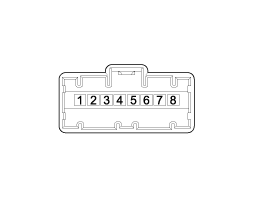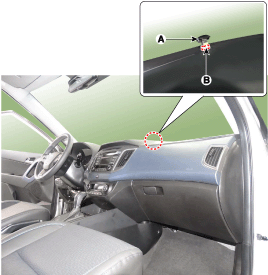Hyundai Creta: Air Conditioning System / Photo Sensor
Description and operation
| Description |
The photo sensor is located at the center of the defrost nozzles.
The photo sensor contains a photovoltaic (sensitive to sunlight) diode. The
solar radiation received by its light receiving portion, generates an electromotive
force in proportion to the amount of radiation received which is transferred
to the automatic temperature control module so that the solar radiation compensation
will be performed.
Repair procedures
| Inspection |
| 1. |
Turn the ignition switch ON.
|
| 2. |
Connect the GDS.
|
| 3. |
Emit intensive light toward the photo sensor using a lamp, and check
the output voltage change.
|
| 4. |
The voltage will rise with higher intensive light and reduce with lower
intensive light.
|
| Replacement |
| 1. |
Disconnect the negative (-) battery terminal.
|
| 2. |
With a flat-head screwdriver, remove the photo sensor (A) from the center
of the defrost nozzle after disconnecting the connector (B).
|
| 3. |
Install in the reverse order of removal.
|
 In-car Sensor
In-car Sensor
Description and operation
Description
The In-car air temperature sensor is built in the heater & A/C control unit.
The sensor contains a thermistor which measures the temperat ...
 Ambient Temperature Sensor
Ambient Temperature Sensor
Description and operation
Description
The ambient temperature sensor is located at the front of the condenser and
detects ambient air temperature. It is a negative type thermistor; ...
Other information:
Lincoln Nautilus 2018-2025 Owners Manual: Programming Your Phone
To program your smartphone as Phone as a
Key:
Visit your device's app store to download
the Lincoln Way app.
Create or sign-in to the Lincoln Way app
and add the vehicle identification number
to your account.
Once you add the vehicle identification
number, follow the prompts in the Linc ...
Lincoln Nautilus 2018-2025 Owners Manual: Refueling
Refueling System Overview
Fuel filler door.
Fuel tank filler valve.
Fuel tank filler pipe.
Refueling Your Vehicle
WARNING: When refueling always
shut the engine off and never allow sparks
or open flames near the fuel tank filler
valve. Never smoke or use a cell phone
while refueling. Fuel ...
В© 2017-2025 www.hcrmangs.com



